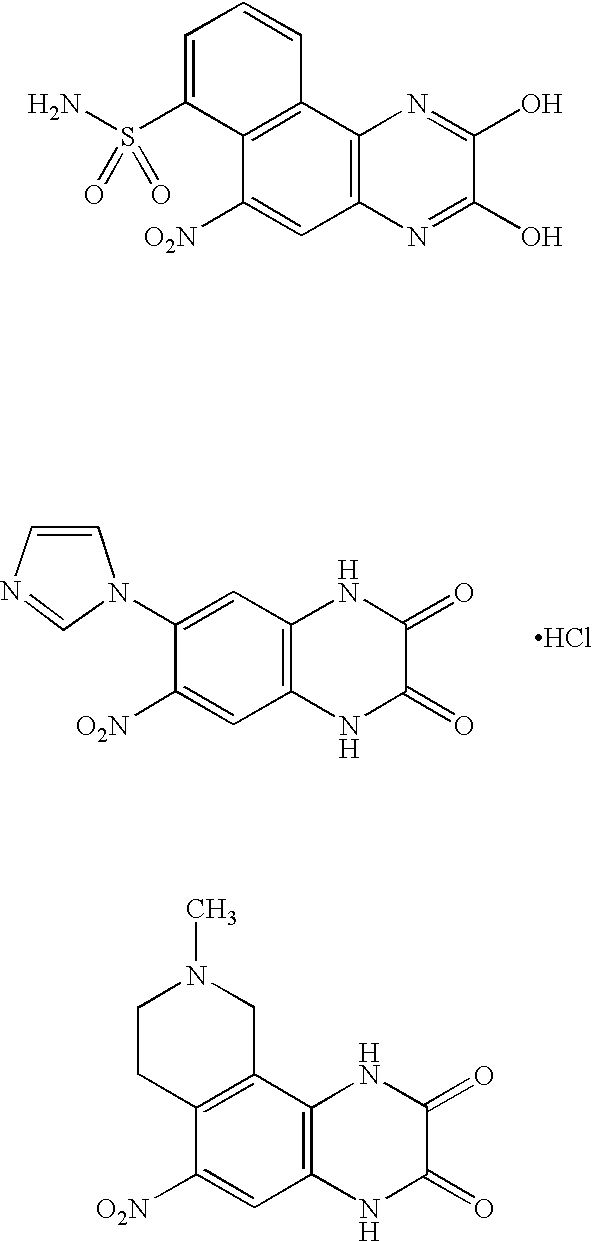Pyridazinone and triazinone compounds and use thereof as pharmaceutical preparations
a technology which is applied in the field of pyridazinone and triazinone compounds, can solve the problems of serious toxicity of said drugs, and achieve the effects of suppressing the neurotoxicity of excitatory neurotransmitters, excellent inhibitory action on ampa receptors, and high clinical efficacy
- Summary
- Abstract
- Description
- Claims
- Application Information
AI Technical Summary
Benefits of technology
Problems solved by technology
Method used
Image
Examples
reference example 1
1-(2-Pyridyl)-3-(3-methoxyphenyl)-2-propen-1-one
[0085] Potassium tert-butoxide (2.4 g) was added to a solution of 2-acetylpyridine (25 g) and 3-methoxybenzaldehyde (28 g) in tetrahydrofuran (150 ml), followed by stirring for 5 hours. The reaction mixture was partitioned between ethyl acetate and water, and the organic layer was washed with water, dried and concentrated. The residue was purified by silica gel column (ethyl acetate-hexane system), to give the title compound (17.2 g) as a yellow solid.
[0086]1H-NMR(400 MHz, CDCl3); δ (ppm) 3.87(s, 3H), 6.96-6.99(m, 1H), 7.24-7.26(m, 1H), 7.32-7.34(m, 2H), 7.50(ddd, 1H), 7.88(dt, 1H), 7.91(d, 1H), 8.19(td, 1H), 8.28(d, 1H), 8.75(ddd, 1H).
reference example 2
2-(3-Methoxyphenyl)-4-(2-pyridyl)-4-oxobutanenitrile
[0087] According to J. Chem. Soc. (1958) 4193, the title compound (16.7 g) was obtained as a brown oil from 1-(2-pyridyl)-3-(3-methoxyphenyl)-2-propen-1-one (17.2 g).
[0088]1H-NMR(400 MHz, CDCl3); δ (ppm) 3.80 (dd, 1H), 3.82(s, 3H), 4.00(dd, 1H), 4.50(dd, 1H), 6.86(dd, 1H), 6.97(t, 1H), 7.00-7.03(m, 1H), 7.29(t, 1H), 7.50(ddd, 1H), 7.86(td, 1H), 8.07(td, 1H), 8.65(ddd, 1H).
reference example 3
2-(3-Methoxyphenyl)-4-(2-pyridyl)-4-oxobutyric acid
[0089] According to J. Heterocyclic. Chem., 25, 799 (1988), the title compound (12.3 g) was obtained as a brown solid from 2-(3-methoxyphenyl)-4-(2-pyridyl)-4-oxobutanenitrile (16.7 g).
[0090]1H-NMR(400 MHz, CDCl3); δ (ppm) 3.52-3.58(m, 1H), 3.77(dd, 1H), 3.79(s, 1H), 8.55(dd, 1H), 6.82(ddd, 1H), 6.85-6.89(m, 1H), 6.94(t, 1H), 6.98(d, 1H), 7.47(ddd, 1H), 7.83(dt, 1H), 8.02(d, 1H), 8.67(ddd, 1H).
PUM
| Property | Measurement | Unit |
|---|---|---|
| temperature | aaaaa | aaaaa |
| temperature | aaaaa | aaaaa |
| temperature | aaaaa | aaaaa |
Abstract
Description
Claims
Application Information
 Login to View More
Login to View More - R&D
- Intellectual Property
- Life Sciences
- Materials
- Tech Scout
- Unparalleled Data Quality
- Higher Quality Content
- 60% Fewer Hallucinations
Browse by: Latest US Patents, China's latest patents, Technical Efficacy Thesaurus, Application Domain, Technology Topic, Popular Technical Reports.
© 2025 PatSnap. All rights reserved.Legal|Privacy policy|Modern Slavery Act Transparency Statement|Sitemap|About US| Contact US: help@patsnap.com



